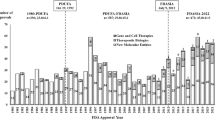Abstract
This report is the sixth in a triennial series by the Tufts Center for the Study of Drug Development examining various aspects of recent new drug approvals in the United States. In 1999, 2000, and 2001 the U.S. Food and Drug Administration’s Center for Drug Evaluation and Research approved 86 new drugs, 82 of which met the Tufts Center for the Study of Drug Development’s definition of a new chemical entity (NCE). Of the 82, 34 (41%) received priority review, while 48 (59%) had standard review. The mean length of the clinical phase (Investigational New Drug Application [IND] filing to New Drug Application [NDA] submission) for the 82 NCEs was 5.5 years, and the mean approval phase (NDA submission to approval) was 1.4 years. Whereas the clinical phase represents a 14% decrease from that value for the previous three-year period, the approval phase remained unchanged. The mean approval phase for priority NCEs (0.9 years) was half that for standard NCEs (1.8 years). Of the 75 NCEs for which foreign marketing data were available, 51 % were first approved for marketing in the United States, while 27% were available in foreign markets one or more years prior to United States approval, with a mean of 6.5 years of prior foreign marketing. The percentage of products first approved in the United States represents a continuation of a trend since passage of the Prescription Drug User Fee Act of 1992 of drug sponsors seeking marketing approval in the United States prior to approval in other markets.
Similar content being viewed by others
References
Prescription Drug User Fee Act of 1992. Public Law 102–571 (1992): 21 USC 379: 106 Stat 4491.
Food and Drug Administration Modernization Act of 1997. Pub Law 105–115 (1997 Nov 21); 21 U.S.C. 355a; 111 Stat 2296.
Kaitin KI. Healy EM. The new drug approvals of 1996, 1997, and 1998: drug development trends in the user fee era. Drug Inf J. 2000:34(2):1–14.
Kaitin KI, Manocchia MA. The new drug approvals of 1993, 1994. and 1995: trends in drug development. Am J Ther. 1997;4(1):46–54.
Kaitin KI, Manocchia M, Seibring M, Lasagna L. The new drug approvals of 1990, 1991. and 1992: trends in drug development. J Clin Pharmacol. 1994;34(2):120–127.
Kaitin KI, DiCerbo PA. Lasagna L The new drug approvals of 1987, 1988, and 1989: trends in drug development. J Clin Pharmacol. 1991:31 (2): 116–122.
Kaitin KI, Richard BW, Lasagna L. Trends in drug development: the 1985–86 new drug approvals. J Clin Pharmacol. 1987:27(8):542–548.
DiMasi JA, Hansen RW, Grabowski HG. The price of innovation; new estimates of drug development costs. J Health Econ. 2003;Mar:22(2):151–185.
Pfizer sees RR&DD rebound, says FDA safety reviews “not inappropriate.” Pink Sheet. 2002:64(38):15–16.
FDA sees drug discovery technology, mergers cutting down on NDAs. Pink Sheet. 2003:65(10):27.
U.S. Food and Drug Administration. Improving innovation in medical technology: beyond 2002. http://www.fda.gov/bbs/topics/NEWS//2003/beyond2002/report.html (Accessed January 31, 2002).
DiMasi JA. New drug development in the United States 1963–1999. Clin Pharmacol Ther. 2001;69 (5):286–296.
DiMasi JA. The value of improving the productivity of the drug development process: faster times and better decisions. PharmacoEcon. 2002;20 (Suppl 3):1–10.
“Sensible regulation” will maintain U.S. lead in Rx launches. FDA says. Pink Sheet. 2003:65(19): 24.
US Food and Drug Administration. Center for Drug Evaluation and Research 2002 report to the nation: improving public health through human drugs, http://www.fda.gov/cder/reports/rtn/2002/rtn2002.pdf (Accessed May 15, 2003).
Reichert JM, Milne C-P. Public and private sector contributions to the discovery and development of ‘impact’ drugs. Am J Ther. 2002;9(12):543–555.
All ethical pharmaceuticals. Medical R&D Healthcare Marketplace Guide. 18th edition. Smith RC, editor. Philadelphia, PA: Dorland, 2003:1-83–85.
Public Health Security and Bioterrorism Preparedness and Response Act of 2002. Public Law 107–116; 116 Stat 594 (Title V, Subtitle, A Prescription Drug User Fees, Sec 501–509).
Author information
Authors and Affiliations
Corresponding author
Rights and permissions
About this article
Cite this article
Kaitin, K.I., Cairns, C. The New Drug Approvals of 1999, 2000, and 2001: Drug Development Trends a Decade after Passage of the Prescription Drug User Fee Act of 1992. Ther Innov Regul Sci 37, 357–371 (2003). https://doi.org/10.1177/009286150303700403
Published:
Issue Date:
DOI: https://doi.org/10.1177/009286150303700403




